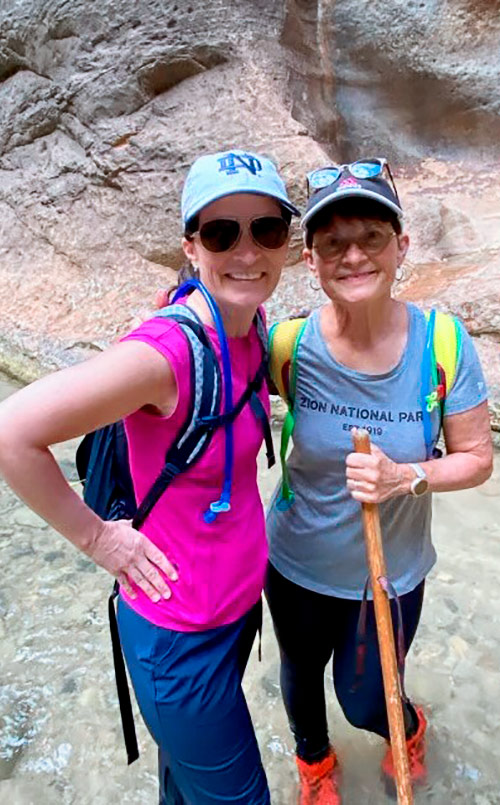An Oasis for Patients with FMD
February 06, 2024

UH Harrington Heart & Vascular Institute draws patients from around the country for its expertise on rare vascular condition
Imagine being told you have a rare health condition for which there is no known cure. Now imagine being told by a doctor that they had absolutely no idea how to help you.
Rosie Miklavcic, RN, MPH, the retired Chief Public Health Nurse of Kentucky who was part of the state’s top medical team, was shocked when this happened to her. But Rosie is a woman determined to find answers to health problems, even if it means crossing state lines.
Her quest led her to cardiologist and vascular medicine specialist Heather Gornik, MD, Director of the Fibromuscular Dysplasia & Arterial Dissection Program at University Hospitals Harrington Heart & Vascular Institute. Dr. Gornik is a leading international expert in the unusual condition known as fibromuscular dysplasia, or FMD. Patients like Rosie have traveled from as far as Hawaii, California, Idaho, Nebraska, Texas and Florida for care at UH Harrington Heart & Vascular Institute.
What Is FMD?
FMD is signified by the abnormal growth of cells in the walls of arteries, generally characterized by a “string of beads” that can cause the vessels to narrow or bulge. There is no known cause or treatment for this condition. Patients must be monitored because these beads can potentially block blood flow to the organs of the body. Areas of the body most commonly affected by FMD are the carotid and vertebral arteries in the neck, as well as the arteries to the kidneys. Many FMD patients have twisted and tortuous arteries and are prone to form aneurysms and dissections.
Some patients with FMD suffer from high blood pressure or migraine headaches. Others have no symptoms at all. Rosie, a lifelong runner, was diagnosed when her calcium was noted as elevated on a blood test. During a physical exam, a doctor detected bruit in her neck, which is a whooshing pulsatile sound that can be heard when listening to blood flow in a patient’s carotid arteries. Some patients with FMD can also hear their own bruits or whooshing, a symptom known as a pulsatile tinnitus.
“The vascular surgeon knew about FMD, but they weren’t really sure what to do with me,” said Rosie, now 72 and diagnosed in her 60s. “They don’t know what causes it, and there is no cure. I was in shock.”
In the Hands of a Leader
UH Harrington Heart & Vascular Institute has one of the largest dedicated programs for FMD and arterial dissection in the world, says Dr. Gornik, who is a member of the Medical Advisory Board of the Fibromuscular Dysplasia Society of America (FMDSA) and serves on the steering committee of the North American Registry for FMD. The registry now contains about 4,000 patients, and UH follows more than 400 of them.
Dr. Gornik noted that no blood test can diagnose FMD. The disease requires an experienced clinician to detect it in arteries on an imaging study such as a special CT or MR angiogram.
Some patients, like Rosie, come to UH annually for ultrasounds to monitor their FMD. Thus far, Rosie has not had any serious complications resulting from her diagnosis.
“More than half of patients with FMD don’t need a procedure at all, just good medical care and follow-up, as well as aspirin or other medications to prevent clots and medications to lower blood pressure and prevent and treat headaches,” says Dr. Gornik. “Approximately one-third of FMD patients have more serious events such as a coronary artery dissection causing a heart attack, carotid or vertebral artery dissection, or stroke.
“We have a terrific multispecialty care team that helps with advanced therapies, when needed, to open blocked kidney arteries and treat aneurysms in the brain, neck and abdomen,” Dr. Gornik added.
A String of Support

A mother of three and grandmother of seven, Rosie remains active. However, since her diagnosis, she has eased off rigorous boot camp and heavy weight workouts in favor of more mild strength training and walking.
In addition to participating in the quarterly international online FMD support group meetings that Dr. Gornik chairs, Rosie is active in the FMDSA and has started a support group in Kentucky’s capital city. The Frankfort, Kentucky-based group that initially had four members in 2018 now has more than 20 participants.
The majority of participants in these support groups, Rosie notes, have symptoms, and many have experienced aneurysms or dissections.
Dr. Gornik is an active listener and a thorough clinician who explains things well for patients, Rosie adds.
“What sets her apart from other physicians is her positive approach to FMD, which is a complex condition,” Rosie said. “I would not go anywhere else. Traveling 350 miles is well worth it.”
Related Links
Learn more about Dr. Gornik and the Fibromuscular Dysplasia Program at UH Harrington Heart & Vascular Institute.


